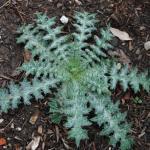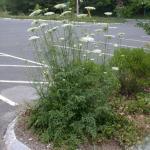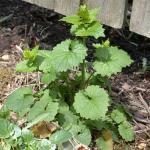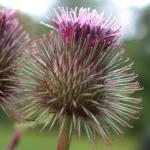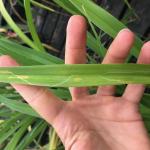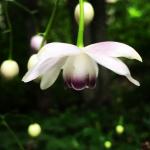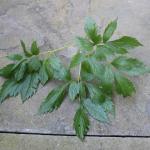A monthly e-newsletter from UMass Extension, published March to October, for home gardeners.
To read the articles in each section of the newsletter, click on the section headings below to expand the content:
Tips of the Month
August is the Month to.....
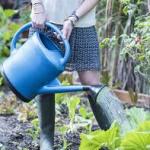 Continue watering young trees and shrubs. Young trees and shrubs require more frequent watering than those that are established. One to two weeks after planting, water daily; 3-12 weeks after planting, water weekly. It generally takes one to two years for the roots to be well established. Adequate, but not excessive, watering results in healthy trees and shrubs. Water deeply to encourage a deep, healthy root system. For young trees, slowly apply 1-1.5 gallons per inch of stem caliper per each watering. For shrubs, apply a volume of water equivalent to ¼ - ⅓ the volume of the container the shrub was grown or purchased in. As roots grow and spread, increase the volume of water. Morning is the best time to water so as to minimize leaf wetness and water loss through evaporation.
Continue watering young trees and shrubs. Young trees and shrubs require more frequent watering than those that are established. One to two weeks after planting, water daily; 3-12 weeks after planting, water weekly. It generally takes one to two years for the roots to be well established. Adequate, but not excessive, watering results in healthy trees and shrubs. Water deeply to encourage a deep, healthy root system. For young trees, slowly apply 1-1.5 gallons per inch of stem caliper per each watering. For shrubs, apply a volume of water equivalent to ¼ - ⅓ the volume of the container the shrub was grown or purchased in. As roots grow and spread, increase the volume of water. Morning is the best time to water so as to minimize leaf wetness and water loss through evaporation.
- Watch for spider mites on plants. Spider mites can be a problem during hot weather. The most troublesome of these is the twospotted spider mite. Twospotted spider mites can be rusty green, brown, or yellow and have two black spots on their back. Mites remove sap from leaf tissues, leaving the leaves with chlorotic spots. The accumulation of these spots is called stippling. When severely infested, the entire plant may become yellow or bronze and may die. To monitor for mites, beat plant foliage on a white paper plate or other white surface. Mites will be easily distinguished from dirt and other debris because they will be moving. Check plants weekly, as outbreak populations can happen very quickly. Avoid over fertilizing plants as excess nitrogen fertilizer can encourage mite outbreaks.
- Start a compost pile. Include disease-free garden debris, grass clippings and fallen tree leaves. Do not include weed plants laden with seeds, since enough seeds will survive the composting process to create a weed problem next year. Do not compost diseased plants – either dispose of them in the trash or in a separate pile which will not be returned to the garden. Locate the compost pile on a level area with good drainage, partial shade and protected from strong winds, which can dry and cool the pile.
- Divide spring and summer blooming perennials. Late August is a good time to start digging and dividing spring and summer blooming perennials. Dividing plants when they are not in bloom allows all the plants’ energy to go to root and leaf growth. Dividing in late August will allow time for them to become established before the ground freezes. Plants that are to be divided should be well watered a day or two beforehand.
- Prune off suckers and water sprouts from fruit trees and some ornamentals. Fruit trees and some tree species such as crabapple produce suckers and water sprouts annually throughout their life, so removing them is part of their regular maintenance. Suckers are vigorous shoots that grow from the trunk or roots. Water sprouts are rapidly growing upright shoots that develop along branches. Water sprouts are usually weakly attached and generally do not flower or fruit as profusely as the other branches. Suckers and water sprouts can be pruned off anytime in the summer.
- Plant a cover crop of oats in vacant parts of the garden. Oats are a cool season annual grass that grows well during the fall. As a cover crop, oats help with weed suppression, nutrient removal and erosion control. Oats are frost killed; they do not survive the winter. Enough growth is needed before first frost to adequately protect the soil, so oats should be planted in mid-August. Oats create a winterkilled ground cover that is easily incorporated into the soil as green manure before planting vegetables or flowers the following spring.
- Remove new flowers on tomato plants. Tomato fruits require eight to nine weeks to ripen after flower set. Flowers that form in August will not have enough time to ripen before frost. Removing flower clusters that form in August will give the remaining fruit a greater chance to ripen.
- Harvest onions. When over half of the tops have fallen over and start to dry, onions are ready to harvest. Carefully pull or dig the bulbs with tops attached. After harvesting, dry (cure) the onions in a warm, dry, well-ventilated location, spreading them in a single layer on a clean dry surface. Cure onions for two to three weeks until the tops and necks are thoroughly dry. After they are properly cured, cut off the tops about 1 inch above the bulbs. Discard any onion bulbs that show signs of decay. Place the cured onions in a mesh bag, wire basket or crate that allows air to circulate throughout the onions. Store onions in a cool, moderately dry location. Storage temperature should be 32 – 40⁰ F and with a relative humidity of 65-70%.
- Prepare soil for seeding a new lawn. Late summer and early fall is the best time to start a new lawn or to seed bare spots in an established lawn, since the warm days and cool nights are ideal for seed germination and seedling growth. Soil testing to determine the nutrient status and pH of your soil is an important part of soil preparation. The UMass Soil Testing Lab’s routine soil analysis is a good start – go to soiltest.umass.edu for more details on fees and how to take a sample. Apply lime and fertilizer as recommended by the soil test report. If the existing topsoil is not adequate to level the soil surface and provide an adequate 4 inches root zone, additional topsoil can be applied. This additional top soil should be free of weedy perennial grasses and stones. A 2-inch deep layer of well-rotted organic matter can also be applied to improve the soil’s drainage. The organic matter and other soil additives should be tilled into the soil to get uniform distribution in the top 4 inches of soil.
Geoffrey Njue, UMass Extension Sustainable Landscapes Specialist
Timely Topics
A Soil Compaction Primer
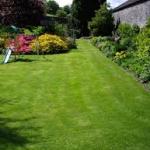 Most home gardeners are familiar with the concept of soil compaction, but many may not understand specifically why it is problematic, how it occurs, and what to do about it when it does occur. In a residential setting, compaction frequently deserves the most attention with regard to lawn areas, but can be an important consideration for landscaped areas and gardens as well.
Most home gardeners are familiar with the concept of soil compaction, but many may not understand specifically why it is problematic, how it occurs, and what to do about it when it does occur. In a residential setting, compaction frequently deserves the most attention with regard to lawn areas, but can be an important consideration for landscaped areas and gardens as well.
The phrase “soil structure” refers not only to the mineral and organic components of soil, but also to a large degree the precious voids interspersed within that structure. Healthy soil contains solid mineral and organic fractions, and open spaces called pores. Soil with “good structure”, therefore, has ample pore space that helps to provide a favorable environment for plant growth. These openings are vital to the functioning of a soil, as they allow infiltration of water into the plant root zone, as well as storage of plant-available water and timely drainage of excess water. Soil pores also provide a means for gas exchange with the atmosphere, along with open pathways that enable easier root growth, allowing plants to expend less energy while producing more extensive root systems.
Compaction describes a condition in which the total amount of pore space in a given volume of soil is reduced, which translates to an overall increase in the density of the soil. This is often caused by compressive forces exerted by foot, automobile, or equipment traffic, which crush soil solids together, thereby eliminating pore space. The effect of these compressive forces is cumulative, meaning that compaction typically worsens over time for soils subject to successive traffic events. Certain factors can also significantly increase the potential for compaction damage:
- Wet soils: water in soil pore spaces essentially “lubricates” solid soil particles, causing them to shift more easily and compress more readily.
- Soils with a high level of fine particles such as silt or clay: soils with smaller particles are more pliable relative to sandier coarser textured soils. Finer-textured soils also have smaller pore spaces which are more quickly destroyed by compressive forces.
- Soils with high levels of organic matter: some level of organic matter is beneficial in soil to promote water and nutrient retention and good soil structure. Since organic matter is typically spongy and easily compressible, too much organic matter however can make a soil prone to compaction, especially when subject to frequent traffic.
Compacted soils can increase plant energy expended for root growth, reduce overall root depth and density, and limit the ability of plants to capture moisture and nutrients from the soil. Water infiltration is less for compacted soils, which can lead to undesirable puddling and runoff, and water drains from compacted soils less efficiently, which can cause waterlogging. Less pore space means less gas exchange with the atmosphere, which is necessary to cycle harmful gases out of the soil and beneficial gases in. The net result is increased plant stress, which decreases plant performance and impairs the ability of plants to deal with other environmental stresses and pests, and to compete with potentially better-adapted weed species for space and resources.
An ounce of prevention is worth a pound of cure where compaction is concerned. Compaction is a chronic problem and when it reaches an excessive level, it can dramatically impair plant growth and is extremely difficult to remedy without disruptive, costly, and time-consuming intervention. Some tips for preventing compaction are as follows:
- Avoid driving or parking automobiles on lawn areas to the greatest extent possible.
- Manage and change-up foot traffic patterns on lawns whenever possible. This might involve periodically re-locating features such as lawn furniture and seating areas, fire pits, play areas, or pet enclosures. Heavily-utilized areas and routes may be better suited to hardscaping or other non-turf alternatives.
- Be conscientious with regard to mowing and other lawn management activities. Alter mowing patterns frequently; avoid following the same route each time. Turn mowers and other equipment around off of the lawn area when possible. Avoid heavier riding equipment in favor of lighter walk-behind equipment where feasible.
- Delay lawn use, management activities, or garden cultivation following heavy rain or when soils are wet (e.g. in early spring).
- Avoid walking in planting beds and rows whenever possible. Restrict foot and equipment traffic in gardens to defined paths. Mulch or other groundcovers can reduce impact on footpaths.
- Events that involve site work such as opening, movement, and placement of soil need special considerations with regard to compaction. Compaction potential is high during construction and planting activities and can have an impact for years to come. Minimize traffic from heavy equipment, avoid equipment traffic on topsoil, and perform work such as mixing or screening away from the final planting site. Temporary barriers like mulch and plywood can also help to reduce impact from project-type work.
Aside from prevention, core aeration is the most useful tool for relieving existing compaction, or as a maintenance exercise to prevent compaction from building to a damaging level. For many lawns, aerating once annually is sufficient to keep compaction in check and soils well aerated. For higher traffic areas, aerating twice or more annually may be appropriate, with some caveats. Remember that heavier, fine textured soils and soils high in organic matter may need to be aerated more frequently, as they will compact more readily than lighter, sandier soils.
Benefits of regular aeration include helping to alleviate excess thatch buildup, as well as increasing soil surface area, which can increase the efficiency and effectiveness of fertilizer, lime, and overseeding inputs. Drawbacks of core aeration include soil disturbance and the potential for bringing weed seeds to the surface. This means that core aeration should typically be avoided in spring during the period of maximum annual weed germination pressure. In most situations, the best time for aeration is late summer, when a favorable period exists for recovery, when weed germination is less of a concern, and aeration can be done in concert with the other beneficial management practices noted above.
Jason D. Lanier, UMass Extension Turf Specialist
News for Gardeners
Weed Life Cycle: Biennials
Biennial weeds reproduce by seed and complete their life cycle in two years. In the first year, they germinate in spring and early summer, then grow vegetatively, forming a leaf rosette at the end of the first growing season. After over-wintering as a rosette, a biennial weed resumes growth in the spring, flowers, produces seed, and completes its life cycle at the end of its second season of growth. Biennials can have large taproots and are sometimes confused with perennials weeds.
Common biennial weeds of lawn and landscape
Management strategies
Lawn
Biennial weeds seldom become a serious problem a turf areas. The repeated mowing used in these areas prevents these weeds from producing seed and, over time, the weed seed bank for these species is depleted. Should they become a problem, biennial weeds can be controlled with a broadleaf herbicide for turf.
Landscape
Biennial weeds are easily managed in ornamental landscape areas. As with all weeds, a landscape mulch is the first and best defense. Seedlings and young biennial weeds can be removed physically by hand-pulling. A direct-spray of a non-selective herbicide can be used to treat large biennial weeds. Be sure to avoid any drift onto neighboring desirable plants.
Vegetable gardens
Biennial weeds are rarely a problem in the vegetable garden. Cultivation used for spring garden preparation and in-season weed removal practices prevent biennial weeds from taking a foothold.
In their second year of growth, biennials send up a flowering stalk. After flowering and seed production, biennials die. Many familiar weeds and wildflowers are biennials. Queen Anne's lace (wild carrot), evening primrose, burdock, common mullein, and moth mullein are examples of biennials found in our area.
Randy Prostak, UMass Extension Weed Specialist
Trouble Maker of the Month
Daylily Leaf Miner (Ophiomyia kwansonis)
Daylily leaf miner damage has been observed both in the landscape and at plant nurseries in Western Massachusetts this summer. Native to Japan and Taiwan, the first sighting of this insect in the USA is believed to have occurred in Maine in 2006. By 2014, it had been identified in 26 states from Maine to Texas.
Adult lily leaf miners are small black flies with red eyes and wide, clear wings. They may be seen resting on leaves or flowers. Adult females lay eggs within the leaves. The larvae hatch and proceed to eat their way through the leaf tissue, creating silvery-white lines on the foliage. Larvae change from off-white to bright yellow as they mature and grow to about 5mm (0.2 inches) in length. Pupae may be found anywhere within the leaf tissue during the growing season, but in the fall they are usually located near the crown of the plant, where they overwinter. Pupae are slightly smaller and light brown in color. In the Northeast, there may be 2-3 generations per year.
Fortunately, the daylily leaf miner is highly host specific - it infests only Hemerocallis species. This is good news for Asiatic lilies (Lilium species), which are having a hard enough time as it is with the lily leaf beetle. Also fortunate is the fact that the damage caused by daylily leaf miners is largely aesthetic and the level of plant injury is typically minor. Remove infested leaves and plant debris and dispose of them in the trash. Examine plants carefully and do not purchase plants on which leaf mines are observed. Contact insecticides will not be effective against eggs, larvae, or pupae. No biological control agents have yet been identified.
Angela Madeiras, UMass Extension Plant Pathologist
Plant of the Month
Anemonopsis macrophylla, False anemone
August is often a time of quiet beauty in shady perennial gardens where there is generally an appropriate reliance on foliage shapes, forms, sizes and colors to provide interest at this time of year. This state of affairs, where foliage reigns, is due in part to the fact that so many popular shade loving plants are early blooming ephemerals whose flowers, and sometimes foliage, have come and gone by mid-summer. Add to this the rush to garden in spring, the nearly insatiable desire for color, and the exuberant acquisition of plants that occurs around Memorial Day and then peters off thereafter, and it’s easy to understand why many gardens, not only shady ones, peak in early summer.
Seasoned gardeners and those in-the-know eventually seek out plants that will carry the day in July and August. Some of those, of course, are wonderful foliage plants, but there are many choices which provide a satisfying floral display as well. In shady borders, cultivars of Anemone, Astilbe, Gentiana, Kirengeshoma, Ligularia, Tricyrtis and are among the perennials that hold out for later bloom, adding both interest and fodder for pollinators in August and September. Unaccountably uncommon and worthy of adding to the list is the lovely False Anemone (Anemonopsis macrophylla), a shade loving perennial which is easy to cultivate, pest and disease resistant, and adds interest from July into September.
Anemonopsis macrophylla is the only member of its genus, and is a member of the buttercup family (Ranunculaceae) along with Anemone, columbine (Aquilegia), and bugbane (Actaea sp.), all which share similar physical characteristics. In fact, the name Anemonopsis alludes to its resemblance to Anemone; Anemon for Amemone and –opsis meaning like. Many similarities exist between the flowers, each bearing numerous individual petals and distinct and numerous stamens and pistils, but false anemone flowers are conspicuously pendant and the petals, which have heavy substance, can only be described as waxy. An outer whorl of petals flares out horizontally above the inner whorl and the petals are lightly blushed with lavender. The inner petals are far shorter, remain pendant, and overlap to form an elegant cup around the stamens and pistils. Each inner petal is trimmed in deep purple with the leading edge traced in a thin line of white.
Two pure white cultivars, ’White Swan’ and ‘Alba’, are even rarer than the species and a double-flowered form, also with pristine white petals, is listed rarely. Flower buds are held on gracefully arching pedicels which depart from wiry, 2’ tall stems. The stems are often ebony-hued, adding to the particular beauty of this plant. Pale green buds dangle expectantly, pearl-like, throughout July only beginning to open in early August, then displaying airy masses of flowers which dance above the deep green foliage until early September. The wiry, leafless stems remain upright while the buds remain closed, but, as the petals unfurl and the flower gains size, the stems begin to lean elegantly, rarely flopping, but rather displaying a relaxed countenance.
The specific epithet, macrophylla, refers to the plants large basal leaves. Each ternately compound leaf expands to 24” across; smaller leaflets are deeply lobed with unevenly serrated edges. In all, the foliage mass is usually 12-15” tall. The foliage is similar to that of black bugbane (Actaea racemosa), but the color of Anemonopsis leaves are slightly darker and boast a distinct sheen. The species is native to the island of Honshu, Japan where it is known in only a few mountainous woodlands, rare now even in its native habitat.
In the garden, this subtle beauty is best situated in full shade or morning light, in rich, organic soil. Ample moisture will produce the most robust and floriferous plants, though it resents excessively moist or soggy locations. The false anemone is particularly resentful of winter wet. Protect from midday sun and drying winds or the foliage will scorch. It is quite hardly, often listed as being suited to USDA hardiness zone 4 (-30 degrees Fahrenheit). I have personally trialed it in the colder part of zone 5 with unfailing success. In 20 or so years, it has not succumbed to rabbit, vole or deer damage, and while it occasionally sports some perforations in foliage from unknown assailants (see photo), it has yet to sustain damage that rises to aesthetically objectionable levels.
When flowering is finished, allow the seeds to mature in their upward facing follicles until the follicle turns brown and splits open (dehisces) to reveal the ripe seeds within. Seeds require a cold period to break dormancy and permit germination. Sowing in flats and leaving outdoors for the winter is a simple way to satisfy the need for cold stratification. Left to its own devices, the false anemone will self-sow gently in the garden. Flowers are self-fertile, so there is no need to start with more than a single plant, though they are best enjoyed in masses and are particularly useful for sloped areas in the shade where the flowers can be viewed from below. When seed dispersal is complete, the foliage, which is deciduous, can be cut to the ground for the winter.
In addition to combining nicely with the closely related plants mentioned above, Anemonopsis is wonderful in borders which include other shade loving companions such as European ginger (Asarum europaeum), creeping phlox (Phlox stolonifera), fairywings (Epimedium), hepatica (Anemone sp,) and early blooming ephemerals like Virginia bluebells (Mertensia virginica), bloodroot (Sanguinaria canadensis), wakerobin (Trillium sp.) and fumeworts (Corydalis sp.).
Joann Vieira, Director of Horticulture, The Trustees of ReservationsAdditional Resources
Landscape Message - for detailed timely reports on growing conditions and pest activity
Home Lawn and Garden Resources
Find us on Facebook! www.facebook.com/UMassExtLandscape/
Follow us on Twitter for daily gardening tips and sunrise/sunset times. twitter.com/UMassGardenClip
Diagnostic Services
The UMass Extension Plant Diagnostic Lab provides, for a fee, woody plant and turf disease analysis, woody plant and turf insect identification, turfgrass identification, weed identification, and offers a report of pest management strategies that are research based, economically sound and environmentally appropriate for the situation. Accurate diagnosis for a turf or landscape problem can often eliminate or reduce the need for pesticide use. Sampling procedures, detailed submission instructions and a list of fees.
The UMass Soil and Plant Nutrient Testing Laboratory at the University of Massachusetts Amherst provides test results and recommendations that lead to the wise and economical use of soils and soil amendments. The Routine Soil Analysis fits the needs of most home gardeners. Sampling procedures plus the different tests offered and a list of fees.
Spread the Word!
Share this newsletter with a friend! New readers can subscribe to our Home Gardener E-Mail List.
